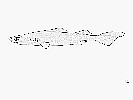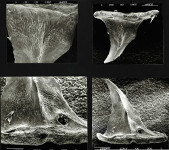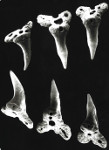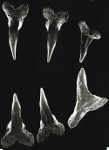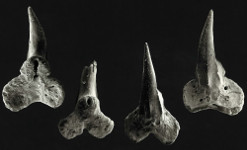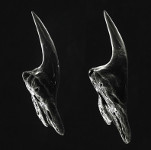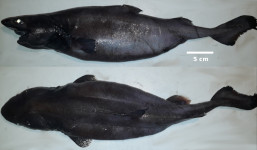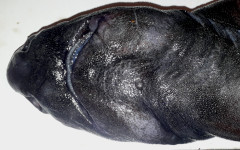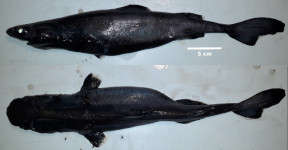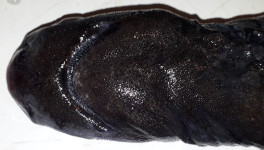Aculeola nigra
De Buen, 1959
Hooktooth dogfish
Classification: Elasmobranchii Squaliformes Etmopteridae
Reference of the original description
Notas preliminares sobre la fauna marina preabismal de Chile, con descripción de una familia de rayas, dos géneros y siete especies nuevos. Boletin del Museo Nacional de Historia Natural de Santiago, 27(3), 171–201
Notas preliminares sobre la fauna marina preabismal de Chile, con descripción de una familia de rayas, dos géneros y siete especies nuevos. Boletin del Museo Nacional de Historia Natural de Santiago, 27(3), 171–201
Description :
Citation: Aculeola nigra De Buen, 1959: In: Database of modern sharks, rays and chimaeras, www.shark-references.com, World Wide Web electronic publication, Version 11/2025
Please send your images of "Aculeola nigra" to info@shark-references.com
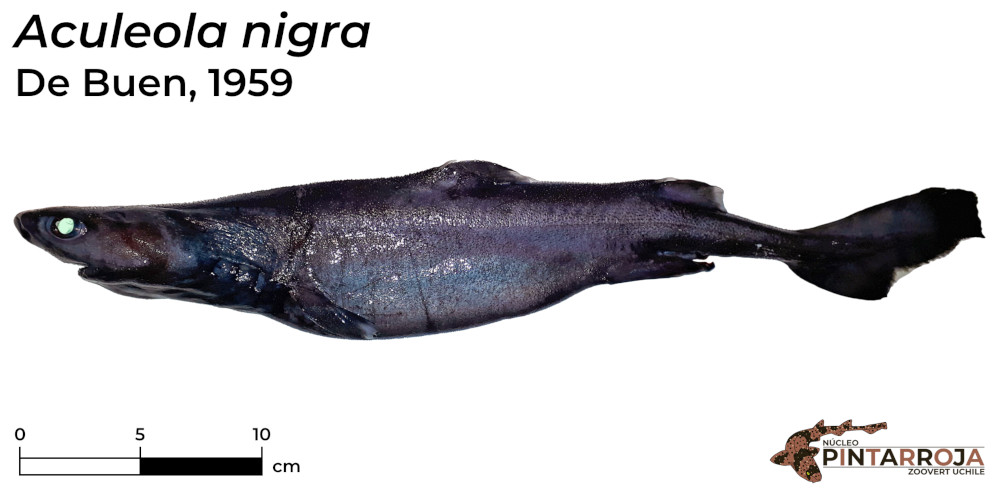
Aculeola nigra De Buen, 1959, Chile © L. Ignacio Contreras, Laboratorio de Zoología de Vertebrados, Facultad de Ciencias, U. de Chile

Aculeola nigra De Buen, 1959, Chile © L. Ignacio Contreras, Laboratorio de Zoología de Vertebrados, Facultad de Ciencias, U. de Chile
Common names
 Tiburón ángel,
Tiburón ángel,  Tollo negro,
Tollo negro,  Tollo negro de cachos,
Tollo negro de cachos,  Ange de l"Atlantique,
Ange de l"Atlantique,  Squale noir,
Squale noir,  Squale noire,
Squale noire,  Hooktooth dogfish
Hooktooth dogfish
 Tiburón ángel,
Tiburón ángel,  Tollo negro,
Tollo negro,  Tollo negro de cachos,
Tollo negro de cachos,  Ange de l"Atlantique,
Ange de l"Atlantique,  Squale noir,
Squale noir,  Squale noire,
Squale noire,  Hooktooth dogfish
Hooktooth dogfish
Short Description
Diagnostic Features after EBERT 2016 [24720]: Head broad and flattened, wider than deep. Snout broadly rounded or subangular, flattened and truncated; snout short, preoral length about 0.5 to 0.6 of mouth width. Spiracles subangular–oval and much shorter than eyes. Gill openings increasing in width posteriorly. Mouth subterminal on head, not extending anterior to eye and ending far behind nostrils. Mouth relatively long and broadly arcuate, length 0.4 to 0.5 of width. Labial furrows without post–labial grooves. A shallow groove between upper lips and upper jaws. Teeth similar in upper and lower jaws, small, not fang–like, with conical hooked cusps, without cusplets or with at most one pair of reduced cusplets, not compressed and blade–like and not imbricate; tooth row counts 60 to 74 upper jaw, 60 to 63 lower jaw. Body stocky. Lateral trunk denticles with thorn–like cusps and stellate bases, denticles sparse and spaced well apart. Claspers elongated, extending well behind free rear tips of pelvic fins. Dorsal–fin spines very short, weak and nearly straight, second dorsal–fin spine not greatly enlarged, slightly larger than first but with its tip falling well below apex of second dorsal fin. Dorsal fins low and elongated, length of first dorsal fin greater than interdorsal space; first dorsal–fin origin over pectoral–fin bases or inner margins; second dorsal fin about as large as first dorsal or slightly smaller. Body with photophores more dense on the ventral surface than the dorsal surface, but no conspicuous black photomarks on underside of head and abdomen, flanks, tail and caudal fin. Vertebral counts: total vertebral count 79, monospondylous vertebral counts 35 to 38, diplospondylous precaudal count 15, total precaudal vertebral counts 50 to 59, caudal vertebral count 20. Intestinal valve with 12 to 14 turns. Moderate sized with a maximum total length of 67 cm. Colour: blackish above and below; fins not abruptly lighter than fin bases; no patch of naked white skin on edge of upper eyelid.
Diagnostic Features after EBERT 2016 [24720]: Head broad and flattened, wider than deep. Snout broadly rounded or subangular, flattened and truncated; snout short, preoral length about 0.5 to 0.6 of mouth width. Spiracles subangular–oval and much shorter than eyes. Gill openings increasing in width posteriorly. Mouth subterminal on head, not extending anterior to eye and ending far behind nostrils. Mouth relatively long and broadly arcuate, length 0.4 to 0.5 of width. Labial furrows without post–labial grooves. A shallow groove between upper lips and upper jaws. Teeth similar in upper and lower jaws, small, not fang–like, with conical hooked cusps, without cusplets or with at most one pair of reduced cusplets, not compressed and blade–like and not imbricate; tooth row counts 60 to 74 upper jaw, 60 to 63 lower jaw. Body stocky. Lateral trunk denticles with thorn–like cusps and stellate bases, denticles sparse and spaced well apart. Claspers elongated, extending well behind free rear tips of pelvic fins. Dorsal–fin spines very short, weak and nearly straight, second dorsal–fin spine not greatly enlarged, slightly larger than first but with its tip falling well below apex of second dorsal fin. Dorsal fins low and elongated, length of first dorsal fin greater than interdorsal space; first dorsal–fin origin over pectoral–fin bases or inner margins; second dorsal fin about as large as first dorsal or slightly smaller. Body with photophores more dense on the ventral surface than the dorsal surface, but no conspicuous black photomarks on underside of head and abdomen, flanks, tail and caudal fin. Vertebral counts: total vertebral count 79, monospondylous vertebral counts 35 to 38, diplospondylous precaudal count 15, total precaudal vertebral counts 50 to 59, caudal vertebral count 20. Intestinal valve with 12 to 14 turns. Moderate sized with a maximum total length of 67 cm. Colour: blackish above and below; fins not abruptly lighter than fin bases; no patch of naked white skin on edge of upper eyelid.
Human uses
fisheries: of no interest
fisheries: of no interest
Biology
Ovoviviparous, number of young at least 3. Size at birth probably about 13 or 14 cm (size of full-term fetuses) [518]. Distinct pairing with embrace [17086].
Ovoviviparous, number of young at least 3. Size at birth probably about 13 or 14 cm (size of full-term fetuses) [518]. Distinct pairing with embrace [17086].
Habitat
demersal; marine; depth range 110 - 560 m
demersal; marine; depth range 110 - 560 m
Remarks
shark-references Species-ID=85;
shark-references Species-ID=85;
Parasites (arranged by Jürgen Pollerspöck)
Copepoda
Copepoda








